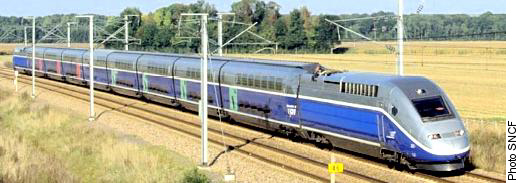 |
 |
 |
 |
 |
 |
 |
 |
 |
 |
TGV Méditerranée emergency stop system |
 |
 |
 |

 |
Passengers on the French south-east high-speed train traveling between Valence and Marseille at nearly 300 km/h are probably not aware that every 10 kilometers they pass near a seismic detection device, which was designed and installed by the CEA's Environmental Assessment and Monitoring Department (DASE), in partnership with SNCF, the French rail company. |
|
 |
|
 |
 Aim Aim |
 |
|
 |
The aim of the system is to automatically slow down or if necessary stop the train a few seconds after detection of an earth tremor liable to deform the tracks, to avoid it reaching the damaged areas at full speed. |
 |
|
 |
 Configuration of the system designed by the CEA/DASE Configuration of the system designed by the CEA/DASE |
 |
|
 |
 |

 |
24 measurement stations, set 10 km apart, are installed along the tracks in the seismic area between Valence, Marseille and Nîmes. |

 |
Seismic station map. |
 |

 |
In the event of ground motion above set thresholds, a central sign posting unit in Marseille, collecting and processing all station data, sends an order to slow down or stop trains to the SNCF system which centralizes all safety alarms for the line. |

 |
Emergency stop system's working principle |
 |

 |
At the same time, a separate automatic decision support system, located in Bruyères-le-Châtel, integrates data from 14 stations of the CEA's national seismic monitoring network, to confirm (or not) the presence of an earthquake within a 10 minute interval. This allows the SNCF to take an informed decision (resume normal operation of the line or inspect the tracks). |
 |

 |
The devices are connected via the SNCF's fiber optic networks and dedicated lines. |
For reliability and security reasons, the emergency stop system's main features are redunded. This system is a world first. Only Japan has set up a system of this kind, but based on a different principle and not suited to the seismic conditions found in south-east France. |
 |
|
 |
 Equipment Equipment |
 |
|
 |
 |

 |
Seismic sensor: triaxial accelerometer (GeoSIG AG). |
 |

 |
Acquisition, GPS dating, event detection and data control unit: Estaque (design: CEA, production: Schneider Electric). |
 |

 |
Seismic processing, data centralizing and real-time decision support based on data from the 24 stations and alarm transmission: UTS (design: CEA, production: Schneider Electric), |
 |

 |
Computer for signal recording, monitoring and control of the network, |
 |

 |
Automatic alarm confirmation system, integrating data from CEA network seismometers. These data provide additional information due to the sensors' superior resolution and more extensive geographical distribution, and are therefore valuable for locating earthquakes and determining their magnitude. |
|
| |
|
|
|